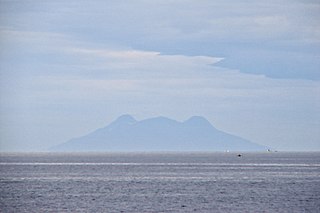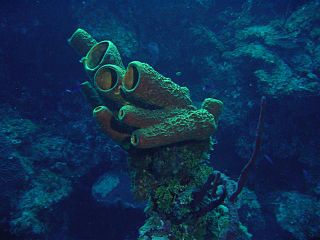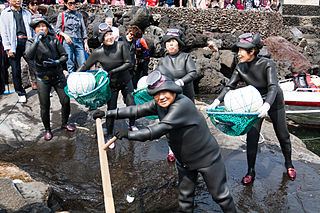
Sulawesi, also known as Celebes, is an island in Indonesia. One of the four Greater Sunda Islands, and the world's eleventh-largest island, it is situated east of Borneo, west of the Maluku Islands, and south of Mindanao and the Sulu Archipelago. Within Indonesia, only Sumatra, Borneo, and Papua are larger in territory, and only Java and Sumatra have larger populations.

The Bohol Sea, also called the Mindanao Sea, is a sea located between the Visayas and Mindanao islands in the Philippines. It lies south of Bohol and Leyte and north of Mindanao. Siquijor and Camiguin are its two major islands.

Cave-diving is underwater diving in water-filled caves. It may be done as an extreme sport, a way of exploring flooded caves for scientific investigation, or for the search for and recovery of divers or, as in the 2018 Thai cave rescue, other cave users. The equipment used varies depending on the circumstances, and ranges from breath hold to surface supplied, but almost all cave-diving is done using scuba equipment, often in specialised configurations with redundancies such as sidemount or backmounted twinset. Recreational cave-diving is generally considered to be a type of technical diving due to the lack of a free surface during large parts of the dive, and often involves planned decompression stops. A distinction is made by recreational diver training agencies between cave-diving and cavern-diving, where cavern diving is deemed to be diving in those parts of a cave where the exit to open water can be seen by natural light. An arbitrary distance limit to the open water surface may also be specified.

The three islands of the Cayman Islands are the exposed top of an underwater mountain. Underwater, the sides of this mountain are quite steep, vertical in some places, within as little as a few hundred metres from shore.

Thursday Island, colloquially known as TI, or in the Kawrareg dialect, Waiben or Waibene, is an island of the Torres Strait Islands, an archipelago of at least 274 small islands in the Torres Strait. TI is located approximately 39 kilometres north of Cape York Peninsula in Far North Queensland, Australia. Thursday Island is also the name of the town in the south and west of the island and also the name of the locality which contains the island within the Shire of Torres. The town of Rose Hill is located on the north-eastern tip of the island.

Ama are Japanese divers famous for collecting pearls, though traditionally their main catch is seafood. The vast majority of ama are women.

Bunaken is an island of 8 km2, part of the Bunaken National Marine Park. Bunaken is located at the northern tip of the island of Sulawesi, Indonesia. It belongs administratively to the municipality of Manado. Scuba diving attracts many visitors to the island.

Pearl hunting, also known as pearling, is the activity of recovering pearls from wild molluscs, usually oysters or mussels, in the sea or freshwater. Pearl hunting was prevalent in the Persian Gulf region and Japan for thousands of years. On the northern and north-western coast of Western Australia pearl diving began in the 1850s, and started in the Torres Strait Islands in the 1860s, where the term also covers diving for nacre or mother of pearl found in what were known as pearl shells.

Haenyeo are female divers in the South Korean province of Jeju, whose livelihood consists of harvesting a variety of mollusks, seaweed, and other sea life from the ocean. Known for their independent spirit, iron will and determination, haenyeo are representative of the semi-matriarchal family structure of Jeju.

Canoe diving and Kayak diving are recreational diving where the divers paddle to a diving site in a canoe or kayak carrying all their gear in or on the boat to the place they want to dive. Canoe or kayak diving gives the diver independence from dive boat operators, while allowing dives at sites which are too far to comfortably swim, but are sufficiently sheltered.

Pearling in Western Australia includes the harvesting and farming of both pearls and pearl shells along the north-western coast of Western Australia.

Bitung is a city on the northern coast of the island of Sulawesi in Indonesia. It is in the province of North Sulawesi, and faces Lembeh Island and the Lembeh Strait, which is known for its colourful marine life, in particular sea slugs. Bitung has a population of 187,932 at the 2010 Census, making it the second most populated city in the province after the capital Manado, rising to 225,134 at the 2020 Census.
The Igara is a wreck off the East Coast of Malaysia that sank on 12 March 1973. At the time of her sinking, the Igara was the largest ever single marine insurance loss in maritime history. Valued at over US$25 million, she was loaded with 127,718 tonnes of Brazilian Iron Ore. The Igara was an Italian ore/oil steamship of 136,400 tonnes deadweight (DWT). It was on voyage from Vitoria to Muroran when after passing through the Sunda Strait, she struck an uncharted rock in the South China Sea about 190 miles (310 km) from Horsburgh Lighthouse, off Mendarik Island, on 11 March 1973. However, she did not sink immediately but continued her voyage until her bow settled submerged and resting on the sea bottom in approx 40 metres of water about 70 miles (110 km) from Singapore. She settled with her entire stern section sticking out of the water. The following day 27 of the 38-man crew abandoned ship, being picked up in their lifeboats by passing vessels. The master and 10 crew stayed on board until 19 March, when she began to break across hold no. 1. Salvors used explosives to cut through the ship at hold no. 1, and the entire rear section of the ship was towed to Japan, where a new forward section was attached and she was renamed the Eraclide.

Bunaken National Park is a marine park in the north of Sulawesi island, Indonesia. The park is located near the centre of the Coral Triangle, providing habitat to 390 species of coral as well as many fish, mollusc, reptile and marine mammal species. The park is representative of Indonesian tropical water ecosystems, consisting of seagrass plain, coral reef, and coastal ecosystems.

East Timor has some of the best dive sites in the world due to its location, warm waters, minimalist tourist trade and lack of commercial fishing or heavy industry.

Hyastenus bispinosus is a species of crab in the family Epialtidae, found around Ambon, the Banda Islands, Timor and the Lembeh Strait off Sulawesi.

SS Oceana was a P&O passenger liner and cargo vessel, launched in 1887 by Harland and Wolff of Belfast and completed in 1888. Originally assigned to carry passengers and mail between London and Australia, she was later assigned to routes between London and British India. On 16 March 1912 the ship collided in the Strait of Dover with the Pisagua, a 2,850 GRT German-registered four-masted steel-hulled barque. As a result Oceana sank off Beachy Head on the East Sussex coast, with the loss of 17 lives.

Lembeh Strait is a strait in Indonesia, separating the islands of Sulawesi and Lembeh. The town of Bitung and Tongkoko volcano are located on the western side of the strait.

Melibe colemani, also known as the Coleman's melibe, ghost nudi, or ghost melibe, is a species of nudibranch in the family Tethydidae. Discovered by Neville Coleman in 2008 off the coast of the island of Mabul in Malaysia, it was formally described by Marta Pola and Terrence Gosliner in 2012 and named in honour of its discoverer. It is found throughout the Coral Triangle region of Malaysia, Indonesia, and the Philippines.

Cave diving is underwater diving in water-filled caves. The equipment used varies depending on the circumstances, and ranges from breath hold to surface supplied, but almost all cave diving is done using scuba equipment, often in specialised configurations with redundancies such as sidemount or backmounted twinset. Recreational cave diving is generally considered to be a type of technical diving due to the lack of a free surface during large parts of the dive, and often involves planned decompression stops. A distinction is made by recreational diver training agencies between cave diving and cavern diving, where cavern diving is deemed to be diving in those parts of a cave where the exit to open water can be seen by natural light. An arbitrary distance limit to the open water surface may also be specified. Despite the risks, water-filled caves attract scuba divers, cavers, and speleologists due to their often unexplored nature, and present divers with a technical diving challenge.


















